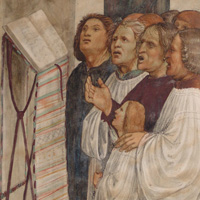
Silent voices. Images of singing in iconographic evidence
lecture
| , from |
|---|
After the end of the winter concert season, the Early music at casa Cozzi project, organised by Fondazione Benetton and almamusica433, continues with a calendar of events scheduled until the start of the summer.
The first is a lecture scheduled for Tuesday, 9 May at 8.30pm. Silent Voices. Images of singing in iconographic evidence, curated by Paolo Da Col. Musician and director of the Ensemble Odhecaton, which performed during the last season, Da Col will come back to Treviso to offer a journey through musical and symbolic painting. Between the Fifteenth and Sixteenth century, chanters, men paid to sing at public and private musical performances or to teach their art, affirmed and strengthened their professionalism. The most important and lively expression of those voices, either soloists or joined in polyphony, sound, has not endured. Images and various associated evidence will provide the sources to illustrate some aspects of the history of Renaissance singers, their training, their vocal skills and their performing methods.
In June, the Early June Festival (Giugno Antico) will enliven the town with concerts and public events, starting from 1 June, when Carlo Boccadoro, musician and composer, will offer a reflection on the topic of Signs and sounds in early and contemporary music.
From 9 to 13 May, at casa Luisa e Gaetano Cozzi (Zero Branco, Treviso), there will also be the second instalment of the Medieval Song and Music workshop. With a view to continuity, the international group of young musicians that last year had taken part in the production of the missa Se la face ay pale by Guillaume Du Fay (1397–1474), will continue working on the trilogy of the French-Flemish composer with the missa L’homme armé, always under the curation of Claudia Caffagni. The teaching residence project aims at enriching performance experience with a philological focus, also thanks to the cooperation of Fondazione Ugo e Olga Levi onlus, which will organise some opportunities for further analysis, including, in May, the lecture on Text sources for studying ancient musical instruments.
